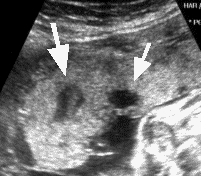What is the significance of a placental lake?
 Placental lakes are enlarged spaces in the placenta filled with
maternal blood. These spaces are also called intervillous spaces because they
are found between the placental villi the finger-like projections of the placenta that contain fetal blood vessels
. The placental villi float in the intervillous spaces and absorb oxygen and
nutrients from the maternal blood.
Placental lakes are enlarged spaces in the placenta filled with
maternal blood. These spaces are also called intervillous spaces because they
are found between the placental villi the finger-like projections of the placenta that contain fetal blood vessels
. The placental villi float in the intervillous spaces and absorb oxygen and
nutrients from the maternal blood.
The blood-filled placental lakes appear nearly black (white arrows) on ultrasound because they do not reflect soundwaves back to the ultrasound machine. Placental lakes can be seen within the placenta or on the fetal surface of the
placenta bulging into the amniotic cavity. Slow swirling blood flow (larger
arrow) may be seen
within the spaces, and the shape of the spaces tends to change with uterine
contractions. These features may help to distinguish a placental lakes from a
thrombus.
Placental lakes are considered to be a normal finding in most cases. However, multiple placental lakes seen early in pregnancy have been associated with fetal
growth restriction. The differential diagnosis of multicystic placental lesions includes, but is not limited to, molar pregnancy, chorioangioma, subchorionic hematoma, and spontaneous abortion with hydropic placental changes. In a patient with placenta previa and previous uterine
surgery multiple placental lakes should raise suspicion for placenta accreta or percreta.
Multiple placental lakes with a thickened placenta suggests gestational trophoblastic disease or placental mesenchymal dysplasia (PMD). The latter is asociated with elevated maternal serum alpha fetoprotein .
Synonyms: Placental caverns, placental venous lakes, placental sonolucencies.
SEE ALSO :
UOG videoclip: Placental lakes vs lacunae: spot the differences
Ultrasound in Obstetrics & Gynecology
UPDATED 2/9/2025
References
1.Reis NS, et al. Placental lakes on sonographic examination: correlation with
obstetric outcome and pathologic findings.J Clin Ultrasound. 2005;33(2):67-71.
PMID: 15674837
2.Thompson MO,; et al. Are placental lakes of any clinical significance?Placenta. 2002;23(8-9):685-90.
PMID: 12361687
3.Jauniaux, E. and Nicolaides, K. H. 1996. Placental lakes, absent umbilical
artery diastolic flow and poor fetal growth in early pregnancy.Ultrasound Obstet Gynecol. 1996 ;7(2):141-4.
PMID: 8776240
4.Nayeri UA, et. al. Systematic review of sonographic findings of placental mesenchymal dysplasia and subsequent pregnancy outcome.Ultrasound Obstet Gynecol. 2013 Apr;41(4):366-74.
PMID: 23239538
5. Hudon L Diagnosis and management of placenta percreta: a review.Obstet
Gynecol Surv. 1998 ;53(8):509-17.
PMID: 9702791

